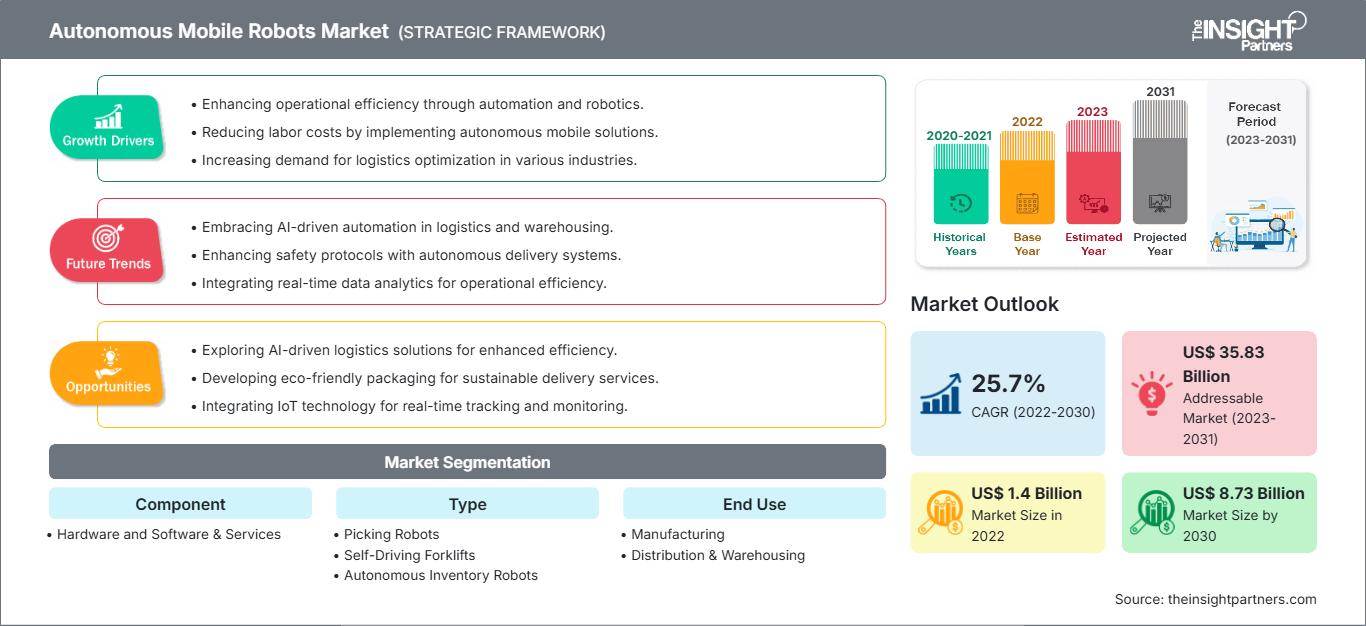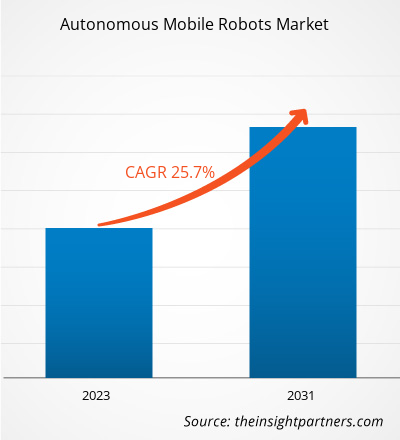自主移动机器人市场规模预计将从 2022 年的 14 亿美元增至 2030 年的 87.3 亿美元。预计该市场在 2022 年至 2030 年期间的复合年增长率将达到 25.7%。自主移动机器人在特定行业应用中的日益普及,很可能仍将是市场的主要趋势。
自主移动机器人市场分析
对提高工业现场工人安全的关注以及对仓库自动化解决方案日益增长的需求正在推动市场发展。由于对快速高效的最后一英里交付的需求不断增长,以及企业对智能解决方案的需求不断增长,预计该市场在预测期内将以显著的速度扩张。此外,各行各业越来越多地采用自主移动机器人,人工智能 (AI) 和机器人技术的持续进步也为市场创造了丰厚的商机。
自主移动机器人市场概览
自主移动机器人 (AMR) 是一种能够独立理解和导航周围环境的机器人。AMR 机器人使用一套复杂的传感器、人工智能、机器学习和计算技术进行路径规划,无需连接电源即可读取和导航周围环境。它们还配备了摄像头和传感器,以便在导航过程中遇到意外障碍物,例如掉落的箱子或人群。AMR 使用防撞等导航技术来减速、停止或重新规划绕过物体的路径,然后再继续执行任务。此外,各行各业对提高运营效率和生产力的需求日益增长,也推动着市场的发展。
自定义此报告以满足您的要求
您将免费获得任何报告的定制,包括本报告的部分内容,或国家级分析、Excel 数据包,以及为初创企业和大学提供超值优惠和折扣
自主移动机器人市场: 战略洞察

-
获取本报告的主要市场趋势。这个免费样本将包括数据分析,从市场趋势到估计和预测。
自主移动机器人市场驱动力与机遇
与提升工业现场工人安全相关的担忧有利于市场
对于在六足机器人场所运营的公司而言,工作场所安全和运营效率是关键挑战。许多企业使用自主移动机器人 (AMR) 执行对人类工人来说危险或无法完成的工作。它们可能用于清洁和消毒空间以提高健康和安全,在医院中搬运传染性实验室样本,在工业环境中搬运重物,或在人类无法工作的极端条件下工作。此外,日益增长的运营复杂性促使企业采用 AMR,通过提高运营效率来增强工业现场工人的安全。例如,日立有限公司在其巴塞罗那工厂部署了一台 MiR200 移动机器人,以简化内部移动,每班次可覆盖高达 12 公里的距离。 MiR200 移动机器人还助力日立公司大幅提升工作场所安全性。
自主移动机器人在各行各业的应用日益广泛
AMR 的适应性和简便性使其能够轻松集成到现有基础设施中,迅速成为制造业、仓储业和物流业的重要组成部分。AMR 可用于执行重型和轻型作业、将产品配送给工作人员以及进行安全检查。在医疗保健行业,AMR 显著满足了各种关键需求,例如消毒、远程呈现以及药品和医疗用品配送,从而为所有人创造了更安全的环境,同时使工作人员能够将更多时间用于患者护理。同样,零售商、银行和酒店业也在使用 AMR,以各种方式提升客户体验,包括库存自动化、客房服务、行李协助和路线导航。此外,制造业、仓储业、物流业、医疗保健业、零售业、银行业和酒店业等的不断扩张也为市场创造了机遇。
自主移动机器人市场报告细分分析
促成自主移动机器人市场分析的关键细分市场是组件、类型和最终用途。
- 根据组件,自主移动机器人市场分为硬件和软件及服务。硬件部分在 2022 年占据了更大的市场份额。
- 按类型划分,市场分为拣选机器人、自动驾驶叉车和自主库存机器人。拣选机器人部分在 2022 年占据了更大的市场份额。
- 就最终用途而言,市场分为制造和分销及仓储。制造部分进一步细分为汽车、航空航天、电子、化学品等。 2022 年,制造业占据了更大的市场份额。
按地区划分的自主移动机器人市场份额分析
自主移动机器人市场报告的地理范围主要分为五个区域:北美、亚太地区、欧洲、中东和非洲以及南美和中美洲。
由于各行各业越来越多地采用 AMR,预计亚太地区的市场在预测期内将扩大。医疗保健、化工、仓储和物流、汽车和制造业等众多行业对 AMR 的需求有所增加,以便轻松管理其复杂的运营。此外,石油和天然气、能源和电力、化工和采矿等危险场所工人安全意识的提高也推动了市场的发展。此外,技术进步和各行各业对智能解决方案日益增长的需求也为市场创造了机遇。
自主移动机器人市场
The Insight Partners 的分析师已详尽阐述了预测期内影响自主移动机器人市场的区域趋势和因素。本节还讨论了北美、欧洲、亚太地区、中东和非洲以及南美和中美洲的自主移动机器人市场细分和地域分布。
自主移动机器人市场报告范围
| 报告属性 | 细节 |
|---|---|
| 市场规模 2022 | US$ 1.4 Billion |
| 市场规模 2030 | US$ 8.73 Billion |
| 全球复合年增长率 (2022 - 2030) | 25.7% |
| 历史数据 | 2020-2021 |
| 预测期 | 2023-2031 |
| 涵盖的领域 |
By 组件
|
| 覆盖地区和国家 |
北美
|
| 市场领导者和主要公司简介 |
|
自主移动机器人市场参与者密度:了解其对业务动态的影响
自主移动机器人市场正在快速增长,这得益于终端用户需求的不断增长,而这些需求的驱动因素包括消费者偏好的不断变化、技术进步以及对产品优势的认知度不断提高。随着需求的增长,企业正在扩展其产品线,不断创新以满足消费者需求,并利用新兴趋势,从而进一步推动市场增长。

- 获取 自主移动机器人市场 主要参与者概述
自主移动机器人市场新闻及最新发展
自主移动机器人市场的评估是通过收集一手和二手资料后进行的定性和定量数据进行的,这些资料包括重要的企业出版物、协会数据和数据库。以下列出了自主移动机器人市场的一些发展:
- AFORMIC Inc. 参加了 MODEX 2024,并展示了其专为灵活制造和仓储而设计的创新型自主移动机器人 (AMR)。该公司向北美市场推出了尖端的内部物流解决方案。AFORMIC Inc. 的智能工厂车队管理套件和定制化的 AMR 旨在重新定义智能工厂的效率和灵活性。 (来源:AFORMIC Inc.,公司网站,2024 年 3 月)。
自主移动机器人市场报告覆盖范围和交付成果
“自主移动机器人市场规模和预测(2020 年–2030 年)”报告对以下领域进行了详细的市场分析:
- 自主移动机器人市场规模以及全球、区域和国家层面对范围内所有关键细分市场的预测
- 自主移动机器人市场趋势以及市场动态,如驱动因素、限制因素和关键机遇
- 详细的 PEST/波特五力模型和 SWOT 分析
- 自主移动机器人市场分析涵盖关键市场趋势、全球和区域框架、主要参与者、法规和最新市场发展
- 行业格局和竞争分析涵盖市场集中度、热图分析、知名参与者和自主移动机器人市场的最新发展
- 详细的公司简介
- 历史分析(2 年)、基准年、预测(7 年)及复合年增长率
- PEST和SWOT分析
- 市场规模、价值/数量 - 全球、区域、国家
- 行业和竞争格局
- Excel 数据集
近期报告
相关报告
客户评价
购买理由
- 明智的决策
- 了解市场动态
- 竞争分析
- 客户洞察
- 市场预测
- 风险规避
- 战略规划
- 投资论证
- 识别新兴市场
- 优化营销策略
- 提升运营效率
- 顺应监管趋势






















 获取免费样品 - 自主移动机器人市场
获取免费样品 - 自主移动机器人市场